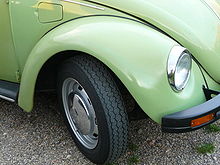Fender (vehicle)
The term fender is used to describe the body parts of vehicles, usually motor vehicles, that are mounted over the wheels.
The purpose of the mudguard is to cover the wheels of a vehicle in sufficient form so that no other road users, in particular pedestrians, are endangered by the turning movement of a free-standing wheel. According to German motor vehicle law (§ 36a StVZO), wheels may not protrude from the bodywork for this reason or must have a cover. Similar regulations exist in other countries. Similarly, mudguards prevent an unnecessarily large swirling of water from the road surface, which could obstruct the visibility of following road users. This would occur in extreme form with free-standing wheels.
The term fender itself originated at a time when carriages still dominated the street scene. The carriages, which were mostly open and pulled by horses at the time, were fitted with covers over the wheels whose curved shape was distantly reminiscent of bird wings. Excrement originally meant "dirt, filth" - as it still does in Austria today - but also stood for horse manure and human feces, which were often still disposed of on the open road at that time. The purpose of these covers was to prevent the wheels of the carriages from flinging the road excrement directly onto the vehicle or even into the interior of the carriage, thus soiling the occupants.
The mudguard fulfils the same function on a bicycle or motorcycle.
· 
Cover over wheels of a carriage (with Kaiser Wilhelm II.)
· 
Fender on a Ford Model T 1924
· 
Fender on a 1938 Chrysler, marked red
·
Left front fender at a VW Golf I
· 
Porsche 911 GT2 with standard fender flares
· 
Free standing mudguard on a simple car trailer

Play media file Whirling up of grains on a road by a moving car

Fender of a VW Beetle
See also
- Mudguard
Search within the encyclopedia
